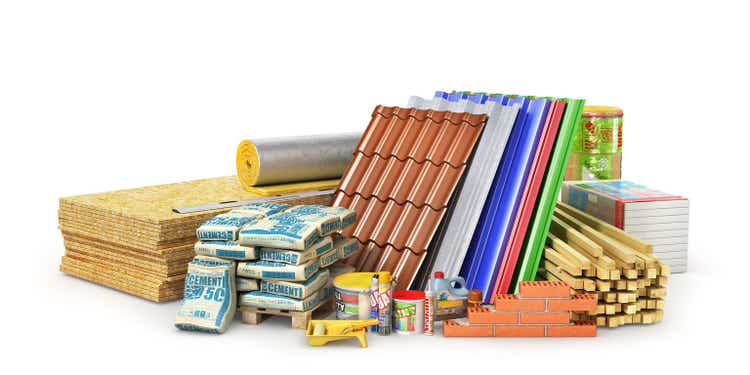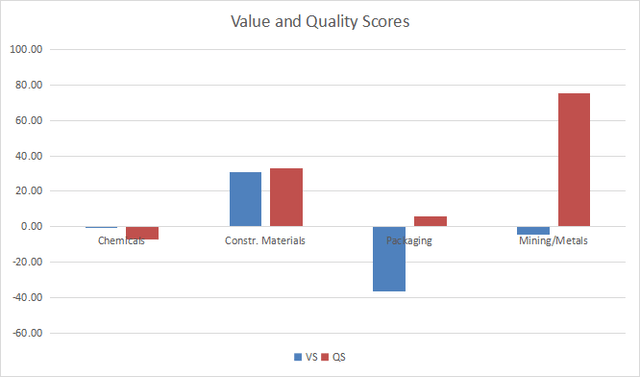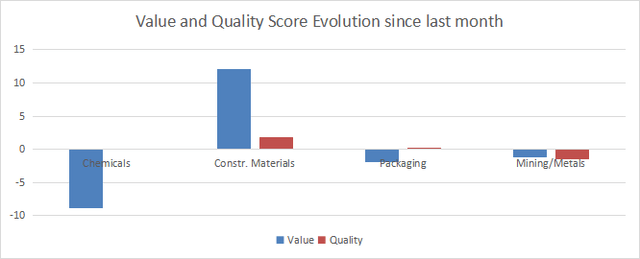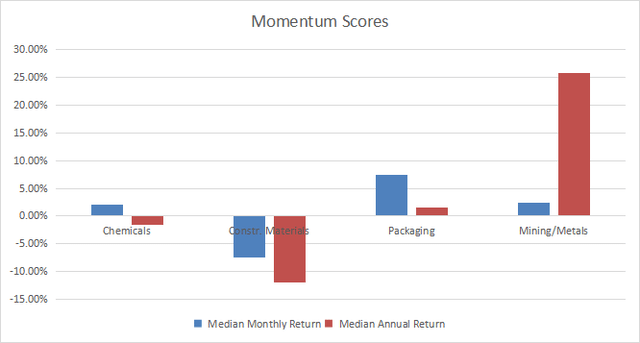urfinguss/iStock via Getty Images
This monthly article series shows a dashboard with aggregate industry metrics in materials. It is also a review of sector ETFs like the Materials Select Sector SPDR ETF (XLB) and the Invesco S&P 500 Equal Weight Materials ETF (NYSEARCA:RTM), whose largest holdings are used to calculate these metrics.
Shortcut
The next two paragraphs in italic describe the dashboard methodology. They are necessary for new readers to understand the metrics. If you are used to this series or if you are short of time, you can skip them and go to the charts.
Base Metrics
I calculate the median value of five fundamental ratios for each industry: Earnings Yield (“EY”), Sales Yield (“SY”), Free Cash Flow Yield (“FY”), Return on Equity (“ROE”), Gross Margin (“GM”). The reference universe includes large companies in the U.S. stock market. The five base metrics are calculated on trailing 12 months. For all of them, higher is better. EY, SY, and FY are medians of the inverse of Price/Earnings, Price/Sales, and Price/Free Cash Flow. They are better for statistical studies than price-to-something ratios, which are unusable or nonavailable when the “something” is close to zero or negative (for example, companies with negative earnings). I also look at two momentum metrics for each group: the median monthly return (RetM) and the median annual return (RetY).
I prefer medians to averages because a median splits a set in a good half and a bad half. A capital-weighted average is skewed by extreme values and the largest companies. My metrics are designed for stock-picking rather than index investing.
Value and Quality Scores
I calculate historical baselines for all metrics. They are noted respectively EYh, SYh, FYh, ROEh, GMh, and they are calculated as the averages on a look-back period of 11 years. For example, the value of EYh for packaging in the table below is the 11-year average of the median Earnings Yield in packaging companies.
The Value Score (“VS”) is defined as the average difference in % between the three valuation ratios (EY, SY, FY) and their baselines (EYh, SYh, FYh). The same way, the Quality Score (“QS”) is the average difference between the two quality ratios (ROE, GM) and their baselines (ROEh, GMh).
The scores are in percentage points. VS may be interpreted as the percentage of undervaluation or overvaluation relative to the baseline (positive is good, negative is bad). This interpretation must be taken with caution: the baseline is an arbitrary reference, not a supposed fair value. The formula assumes that the three valuation metrics are of equal importance.
Current data
The next table shows the metrics and scores as of last week’s closing. Columns stand for all the data named and defined above.
|
VS |
QS |
EY |
SY |
FY |
ROE |
GM |
EYh |
SYh |
FYh |
ROEh |
GMh |
RetM |
RetY |
|
|
Chemicals |
-0.73 |
-6.99 |
0.0404 |
0.3874 |
0.0276 |
16.52 |
40.17 |
0.0440 |
0.4650 |
0.0225 |
17.96 |
42.70 |
2.08% |
-1.61% |
|
Constr. Materials |
30.89 |
33.12 |
0.0546 |
0.9591 |
0.0269 |
15.14 |
30.19 |
0.0262 |
0.9140 |
0.0339 |
9.46 |
28.42 |
-7.50% |
-12.00% |
|
Packaging |
-36.37 |
5.96 |
0.0470 |
0.7788 |
0.0074 |
20.78 |
23.69 |
0.0478 |
1.0671 |
0.0378 |
17.59 |
25.27 |
7.51% |
1.47% |
|
Mining/Metals |
-4.31 |
75.51 |
0.0635 |
1.1461 |
0.0057 |
18.79 |
24.13 |
0.0390 |
1.1587 |
0.0225 |
8.08 |
20.36 |
2.37% |
25.91% |
Value and Quality chart
The next chart plots the Value and Quality Scores by industry (higher is better).
Value and quality in materials (Chart: author; data: Portfolio123)
Evolution since last month
The value score has improved in construction materials and deteriorated in chemicals.
Score variations (Chart: author; data: Portfolio123)
Momentum
The next chart plots momentum data.
Momentum in Materials (Chart: author; data: Portfolio123)
Interpretation
This sector is very close to 11-year averages in aggregate valuation metrics according to my S&P 500 monthly dashboard for April. Combining value and quality scores, the best-looking subsector is construction materials. It is far above the baseline in both value and quality scores. Mining/metals is slightly overvalued relative to the baseline (by less than 5%), but it has an excellent quality score. Chemicals are close to the baseline in both value and quality. Packaging is the less attractive industry here: it is overvalued by about 36% relative to the baseline. Its quality score is good, but not high enough to justify such overvaluation.
Fast facts on RTM
The Invesco S&P 500 Equal Weight Materials ETF has been tracking the S&P 500 Equal Weight Materials Index since 11/01/2006. It holds 28 stocks and has a total expense ratio of 0.40% (vs. 0.12% for the capital-weighted ETF XLB).
The next table shows RTM has significantly outperformed XLB since inception in total return and Sharpe ratio (risk-adjusted performance). The difference in annualized return is about 2 percentage points.
|
Total Return |
Annual. Return |
Drawdown |
Sharpe ratio |
Volatility |
|
|
RTM |
393.87% |
10.91% |
-60.49% |
0.54 |
21.78% |
|
XLB |
268.58% |
8.82% |
-59.66% |
0.47 |
20.94% |
Data calculated with Portfolio123
RTM is also cheaper than XLB in price/earnings. The difference in other usual valuation ratios is less meaningful, but still in favor of the equal-weight ETF:
|
RTM |
XLB |
|
|
Price / Earnings TTM |
18.16 |
20.16 |
|
Price / Book |
3.14 |
3.28 |
|
Price / Sales |
1.91 |
2.32 |
|
Price / Cash Flow |
12.3 |
13.07 |
Data: Fidelity
RTM is much less exposed to risks related to individual companies. Its largest holding weighs 4% of asset value (vs. 16% for XLB’s top holding) and the top 10 holdings have an aggregate weight of 37% (more than 62% for XLB).
In summary, RTM is a good product for investors seeking exposure to basic materials without the concentration in top holdings of capital-weighted ETFs. It is also better in valuation and past performance. RTM seems to be a better long-term investment. However, XLB is a better instrument for trading and tactical allocation strategies thanks to much higher trading volumes.
Dashboard List
I use the first table to calculate value and quality scores. It may also be used in a stock-picking process to check how companies stand among their peers. For example, the EY column tells us that a chemical company with an Earnings Yield above 0.0404 (or price/earnings below 24.75) is in the better half of the industry regarding this metric. A Dashboard List is sent every month to Quantitative Risk & Value subscribers with the most profitable companies standing in the better half among their peers regarding the three valuation metrics at the same time. The list below was sent to subscribers several weeks ago based on data available at this time.
|
Olin Corporation |
|
|
Cleveland-Cliffs Inc. |
|
|
LyondellBasell Industries N.V. |
|
|
Trinseo PLC |
|
|
UFP Industries, Inc. |
|
|
Freeport-McMoRan Inc. |
|
|
Dow Inc. |
|
|
The Chemours Company |
|
|
Greif, Inc. |
It is a dynamic monthly list with a statistical bias toward excess returns on the long term, not the result of an analysis of each stock.


Be the first to comment